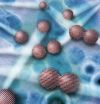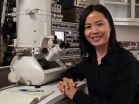Gourmet butterflies speed north
2012-05-28
(Press-News.org) A new study led by scientists in the Department of Biology at the University of York has shown how a butterfly has changed its diet, and consequently has sped northwards in response to climate change.
Their study is published in the latest issue of Science.
The researchers found that warmer summers have allowed the Brown Argus butterfly to complete its life cycle by eating wild Geranium plants. Because the Geraniums are widespread in the British countryside, this change in diet has allowed the butterfly to expand its range in Britain at a surprisingly rapid rate. Over the past 20 years, the Brown Argus has spread northwards by around 79 kilometres and has become common in the countryside in much of southern England.
Lead author PhD student Rachel Pateman, of the University of York's Department of Biology and the NERC Centre for Ecology & Hydrology, said: "Many species are shifting their distributions northwards as the climate warms, but this previously scarce species has surprised everyone by moving its range at over twice the average rate."
Co-author Chris Thomas, Professor of Conservation Biology at York, said: "Because wild Geraniums are widespread in the landscape, the butterflies can now move from one patch of host plants to next and hence move rapidly through the landscape – expanding their range generation after generation."
Co-author David Roy, from the NERC Centre for Ecology & Hydrology, said: "The change in diet represents a change to the interactions between species – in this case between a butterfly and the plants that its caterpillars eat – caused by climate warming. Changes to the interactions between species are often predicted to alter the rate at which species shift their distribution in response to climate change; and now we have demonstrated this in nature."
In the 1980s the butterfly was considered scarce in Britain, with populations undergoing continued decline but it has subsequently undergone a dramatic reversal of fortune. The team put this down to the effect of climate on the ability of the butterfly to use additional food plant species.
In the 1980s, the caterpillars were mainly confined to Rockrose plants growing on the chalk hills of southern England, but the use of plant species in the Geranium family has increased as summer temperatures have increased. Wild Geraniums are suitable food plants for the caterpillars in warm years, but not in colder summers. This seems to be because the plants grow in different places, which provide different microclimates. Common Rockrose is found mainly on hot south-facing slopes, where the butterfly can complete its life cycle even in cool summers. This is not the case for the Geraniums and so they only become suitable for the butterfly when summers are warm.
Co-author Richard Fox, from the charity Butterfly Conservation, said: "It is important that we understand how and why species are responding to climate change. Such research would not be possible without the thousands of records of butterflies our dedicated volunteers have collected over many decades, which have allowed us to detect these long term changes."
Rachel Pateman said: "This study has highlighted that species do not respond to climate change in isolation, and that climate change affects how species interact with one another. In the case of the Brown Argus butterfly, changes in interactions with its food plants have helped it to respond to climate change very rapidly. However, changes to interactions may hinder other species, potentially putting them at risk of extinction."
Co-author Professor Jane Hill, of the Department of Biology at the University of York, said: "There will be winners and losers from climate change. It is important that we begin to understand how the complex interactions between species affect their ability to adapt to climate change so we can identify those that might be at risk and where to focus conservation efforts."
### END
ELSE PRESS RELEASES FROM THIS DATE:
2012-05-28
Our cells breathe and digest, as does the organism as a whole. They indeed use oxygen to draw the energy contained in the nutrients they ingest, before discarding the waste, as carbon dioxide and water. Glucose is a preferred nutrient for the cells. Its digestion occurs in the cytoplasm, in the absence of oxygen, and leads to the formation of pyruvate and a small amount of energy. Pyruvate is then carried into mitochondria, the cell's power plants, for a complete burning, thus providing a maximal energetic yield.
A mediocre energetic yield in tumor cells
'As opposed ...
2012-05-28
Science magazine has awarded a prize for Inquiry-Based Instruction to a Case Western Reserve University class that melds biology, computer modeling, mathematical analysis and writing.
"Dynamics of Biological Systems," taught by Biology Professor Hillel Chiel and three graduate assistants, abandons traditional lectures altogether in favor of learning by doing. The teachers call the class an example of the use of the continual improvement model in education.
In it, Chiel pairs biology majors with engineering, physics or math majors, and has them concentrate on building ...
2012-05-28
Through biomineralization, nature is able to produce such engineering marvels as mother of pearl, or nacre, the inner lining of abalone shells renowned for both its iridescent beauty and amazing toughness. Key to biomineralization is the phenomenon known as "oriented attachment," whereby adjacent nanoparticles connect with one another in a common crystallographic orientation. While the importance of oriented attachment to biomineral properties long has been recognized, the mechanism by which it occurs has remained a mystery. With a better understanding of oriented attachment ...
2012-05-28
VIDEO:
Berkeley Lab researchers at the National Center for Electron Microscopy recorded real-time observations of nanocrystal growth that support the theory of nanoparticles acting like artificial atoms. This electron microscopy movie...
Click here for more information.
In the growth of crystals, do nanoparticles act as "artificial atoms" forming molecular-type building blocks that can assemble into complex structures? This is the contention of a major but controversial ...
2012-05-28
Boston, MA —Harvard School of Public Health (HSPH) researchers have found that detailed knowledge about your genetic makeup—the interplay between genetic variants and other genetic variants, or between genetic variants and environmental risk factors—may only change your estimated disease prediction risk for three common diseases by a few percentage points, which is typically not enough to make a difference in prevention or treatment plans. It is the first study to revisit claims in previous research that including such information in risk models would eventually help doctors ...
2012-05-28
(SALT LAKE CITY)—Research into how carbohydrates are converted into energy has led to a surprising discovery with implications for the treatment of a perplexing and potentially fatal neuromuscular disorder and possibly even cancer and heart disease.
Until this study, the cause of this neuromuscular disorder was unknown. But after obtaining DNA from three families with members who have the disorder, a team led by University of Utah scientists Jared Rutter, Ph.D., associate professor of biochemistry and Carl Thummel, Ph.D., professor of human genetics, sequenced two genes ...
2012-05-28
CORVALLIS, Ore. — There's nothing like a new pair of eyeglasses to bring fine details into sharp relief. For scientists who study the large molecules of life from proteins to DNA, the equivalent of new lenses have come in the form of an advanced method for analyzing data from X-ray crystallography experiments.
The findings, just published in the journal Science, could lead to new understanding of the molecules that drive processes in biology, medical diagnostics, nanotechnology and other fields.
Like dentists who use X-rays to find tooth decay, scientists use X-rays ...
2012-05-28
Research from Karolinska Institutet in Sweden shows that the human olfactory bulb – a structure in the brain that processes sensory input from the nose – differs from that of other mammals in that no new neurons are formed in this area after birth. The discovery, which is published in the scientific journal Neuron, is based on the age-determination of the cells using the carbon-14 method, and might explain why the human sense of smell is normally much worse than that of other animals.
"I've never been so astonished by a scientific discovery," says lead investigator Jonas ...
2012-05-28
A new type of male contraceptive could be created thanks to the discovery of a key gene essential for sperm development.
The finding could lead to alternatives to conventional male contraceptives that rely on disrupting the production of hormones, such as testosterone and can cause side-effects such as irritability, mood swings and acne.
Research, led by the University of Edinburgh, has shown how a gene – Katnal1 – is critical to enable sperm to mature in the testes.
If scientists can regulate the Katnal1 gene in the testes, they could prevent sperm from maturing ...
2012-05-28
A research team led by the University of Melbourne and Monash University, Australia, has discovered why people can develop life-threatening allergies after receiving treatment for conditions such as epilepsy and AIDS.
The finding could lead to the development of a diagnostic test to determine drug hypersensitivity.
The study published today in the journal Nature, revealed how some drugs inadvertently target the immune system to alter how the body's immune system perceives it's own tissues, making them look foreign.
The immune system then attacks the foreign nature ...
LAST 30 PRESS RELEASES:
[Press-News.org] Gourmet butterflies speed north

